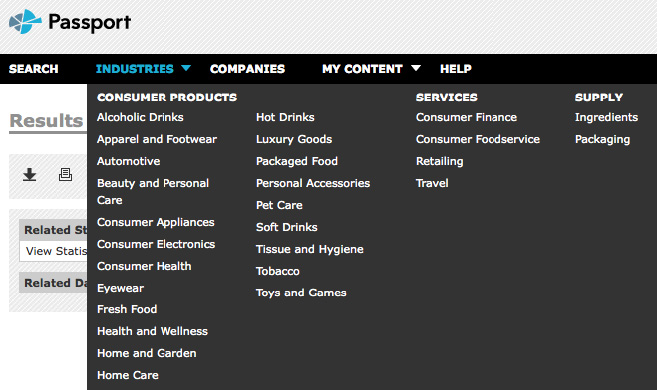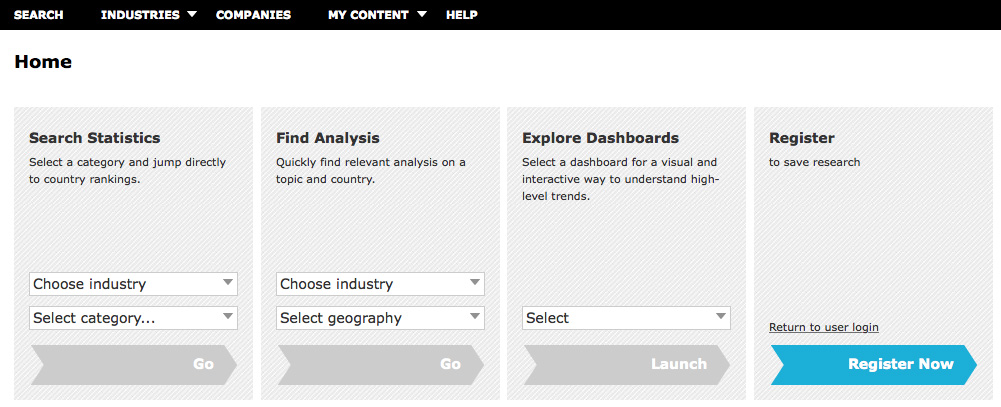Resource Review[1]
Euromonitor International’s Passport
Skip other details (including permanent urls, DOI, citation information)
: This work is licensed under a Creative Commons Attribution-NonCommercial-NoDerivatives 3.0 License. Please contact mpub-help@umich.edu to use this work in a way not covered by the license.
For more information, read Michigan Publishing's access and usage policy.
Passport (formerly known as Global Market Information Database, or GMID) is a subscription- based database, one of several market research solutions produced by Euromonitor International (EI). Anyone who has ever read or used SWOT reports in research may have encountered those authored by EI and its legions of analysts, who are located in nearly every corner of the globe. EI’s mission is to “create data and analysis on thousands of products and services around the world.”[3] More specifically, EI’s analysts gather data on about twenty-nine consumer product industries in over eighty countries. They find out what consumers bought, track what consumers are buying, and use these insights to predict what consumers will buy in the future.
Passport is EI’s flagship product: a central clearinghouse for the firm’s intellectual output. Through Passport, one can access various types of information, all authored by EI’s analysts, on all consumer goods industries (see fig. 1):
- industry reports and forecasts
- company profiles
- articles and opinion pieces from EI analysts
- country reports
- global reports
- podcasts
- videocasts
- datagraphics
- “vis apps” (interactive infographics)
Analysts in EI’s offices worldwide collect information firsthand; they also assimilate information from various government agencies and trade authorities.[4]
 Figure 1. Passport screenshot, showing industries included in the clearinghouse. Source: © Euromonitor International.
Figure 1. Passport screenshot, showing industries included in the clearinghouse. Source: © Euromonitor International.Applicability for Media Industry Studies
It might not be readily apparent why a resource like Passport would be useful to media industry scholars; it is true that researchers in business schools are more likely to use this database than those in film and media schools. Passport, however, presents media industry scholars with a few unique research opportunities, including the ability to:
- enrich research with data that comes directly from Euromonitor’s researchers
- explore licensing relationships between film/television/video game producers and consumer goods industries
- gauge potential correlations between consumer behavior and policy shifts, media spectacles, commercial campaigns, etc.
- track sales and adoption rates for technologies including gaming platforms, audiovisual equipment, and mobile devices
- read studies on consumer beliefs and behavior, such as “Future Spending Habits” and “Attitudes toward the Internet”—just two categories among others in the Portable Consumer Electronics area
- see business analysts’ forecasting essays, for example, “Will the Kids Lose Interest in Tablets?” and “When Toys Meet Video Games: Where Are the Opportunities?”
Content and Usability
The amount of information in Passport is almost overwhelming. Fortunately for users, EI has put together an interface that is powerful, yet easy to use. Upon entering the database, the user has three basic options: a simple keyword search, a ubiquitous navigation menu, or a set of search tools available on the home page.
Option 1 is the keyword search box, located in the upper right-hand corner of the screen. Use this option to search a specific company name and retrieve such background information as which market sectors the company has infiltrated or its countries of operation. Because of the vast nature of this resource, users should always use the keyword search with a specific search term. My keyword search of “Disney,” for example, retrieved nearly four hundred documents—a rather unwieldy amount. Rather than wade through vast search result sets, however, users can take advantage of Passport’s multiple filtering options to drill down to the most relevant information quickly.
My test search presented me with filters that narrowed my search by category (i.e., industry), by geography, by statistics, by analysis (i.e., document type), and by date (see fig. 2). Looking with the “By Category” filter, I quickly scanned the list and saw that Disney is mentioned in reports scattered over one hundred different market sectors—a testament to the company’s licensing power. Included in this list was everything from the expected—117 toys-and-games industry documents—to the surprising: one document on Disney’s dealings with the “Yoghurt and Sour Milk Products” industry (an opinion piece on the US dairy market’s future that mentioned a child-targeted licensing deal between Chobani and Disney).
Passport’s Option 2 is to use the horizontal navigation menu to access one of the following three functions:
- a guided search, which enables a user to build a custom set of search results through an interactive decision tree;
- a drop-down listing of industries in Passport; clicking one of the industries calls up a screen where one can narrow your search or create a ranking;
- a company search, which returns a company profile (help text assists with finding official company names)
Option 3 is to use one of the featured search tools presented on the home page. These tools are particularly useful if one knows beforehand the type of information desired. “Explore Dashboards” is the most noteworthy option of the three. Unlike “Search Statistics” or “Find Analysis,” which ultimately lead to reports and articles, selecting an industry in “Explore Dashboards” calls up an interactive world map that shows market size for the selected category of goods in each country. Users can explore individual countries in detail, change to a subsection of a category, or switch to view the data in scatterplot or bar chart format. If a researcher wanted to know the countries in which Apple enjoys the largest market share, for example, he or she could use the Dashboard for Consumer Electronics and customize it to show Apple’s data only: this is just one example of the Dashboard’s capability.
Lastly, Passport allows users to set up individual profiles. Users who register on the site are able to save documents for later review. Clicking a paper clip symbol sends items to the “My Content” area. This function can be accessed either via the homepage or in the navigation menu’s “My Content” option.
 Figure 3. Screenshot of Passport home page, showing Option 2 and Option 3. Source: © Euromonitor International
Figure 3. Screenshot of Passport home page, showing Option 2 and Option 3. Source: © Euromonitor InternationalRelated Products
In a 2011 review in the Charleston Advisor, business librarian Joan Giglierano compared several industry research databases and concluded that “Passport GMID is the Cadillac of international industry information sources.”[5] Some of the comparable tools currently available are: Mintel Reports (Mintel), MarketLine Advantage (Datamonitor) and Global Industry Research Reports (IBISWorld). All of these products are subscription based, with similar though not identical content. EI also offers a scaled-down, presumably less expensive, version of Passport called Research Monitor. The main differences between these products are the places and industries covered (and level of specificity), how each firm organizes the industries it tracks, and interface design/functionality. Comparisons more detailed than this brief overview are abundant and can be found in library science periodicals like the Charleston Advisor.
Conclusion
Passport is a highly useful resource for industry scholars, but not every institution can afford a subscription to this “Cadillac.” EI does not publicize its pricing structure. Subscription costs are based on enrollment numbers, so larger institutions will pay more than smaller ones. Euromonitor, as well as some of its competitors, sell some of their reports à la carte, so those whose institutions can’t afford subscriptions can still access certain portions of the content—for a fee, of course.
Passport won’t be much help for media industry researchers seeking information on a specific movie, television show, or video game. However, it is a powerful tool for data and insight on consumer activities, technology adoption rates, and more. If you are lucky enough to study or work at an institution with Passport or one of its competitors, take some time to explore and see for yourself how these market research tools can augment your media industry research.
Media Industries Reviews highlight new or obscure academic resources of particular utility for industry scholars. These reviews expound upon the potential strengths weaknesses of each resource as well as potential research applications for scholars and specifically interested in studying the media industries. Please consult our review page for more information.

Nedda Ahmed, MLS, is Arts Librarian at Georgia State University. She has nearly fifteen years of experience providing research assistance to scholars in cinema and media studies and enjoys training other librarians in media industries research tools and resources. She can be reached at nedda [AT] gsu.edu or via Twitter: @neddaahmed.

“About UsEuromonitor International,” accessed June 2, 2015.

“Research Methodology,” Euromonitor International, accessed June 2, 2015,.

Joan Giglierano, “Comparative Review of IBISWorld Global Industry Reports, Euromonitor Research Monitor, and Mintel Global Market Navigator,” Charleston Advisor 13, no. 2 (October 2011): 10–15, doi:10.5260/chara.13.2.10.

Copyright © 2015 (Nedda Ahmed). Media Industries is an open-access, peer-reviewed, online academic journal. As such, we aim to participate in the open exchange of information. This work is licensed under a Creative Commons Attribution Noncommercial No Derivatives (by-nc-nd) License. Under this license, this work is available for sharing and noncommercial distribution provided the appropriate attribution is given.



